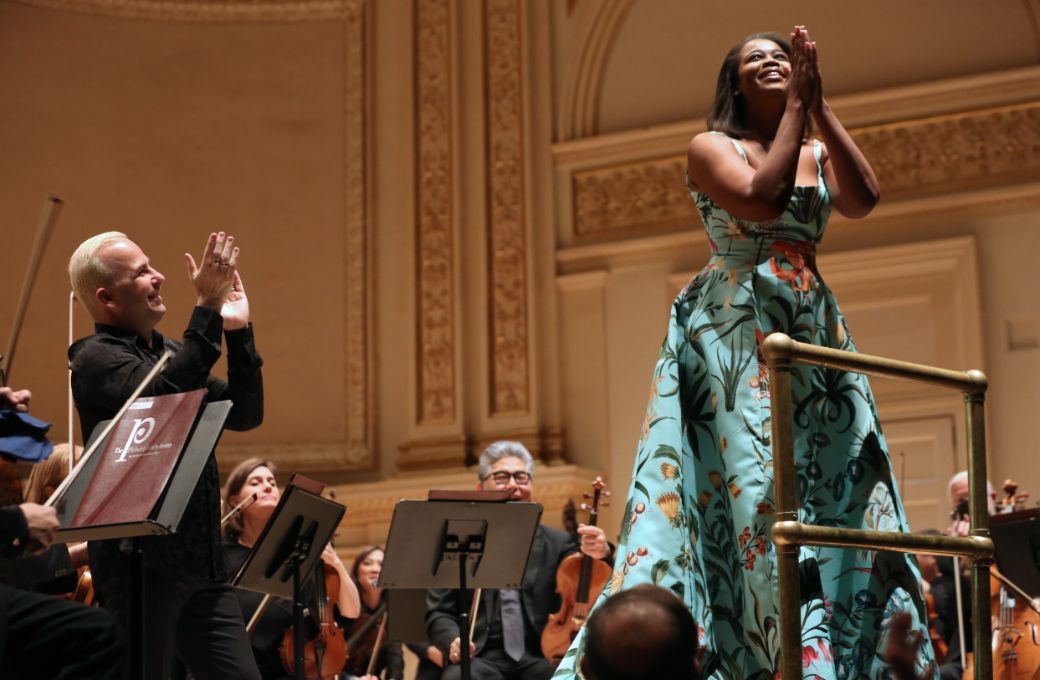In the waning months of Jaap van Zweden’s tenure at the helm of the New York Philharmonic, Yannick Nézet-Séguin – music director of both the Metropolitan Opera and the Philadelphia Orchestra – has clearly become New York’s driving musical force. After opening the Carnegie Hall season for the second year in the row, the Philadelphians and their maestro continue to offer programmes that satisfy the public’s appetite for both novelties and for pillars of the repertoire. Their most recent performance ticked several right boxes: it included a local premiere alongside beloved masterpieces; it drew attention to the extraordinary quality of the orchestra’s instrumentalists with clarinetist Ricardo Morales as soloist in the Mozart Concerto; it allowed the public to get a glimpse of Pretty Yende, one of the great operatic sopranos of today.
Commissioned by the Philadelphia Orchestra, Xi Wang’s Ensō has its roots, like several of her prior works, in a physical shape. Ensō is a sacred symbol in Zen Buddhism, a circle painted with a single, continuous brush stroke, evoking the experience of attaining enlightenment. The act of drawing the shape is musically represented by stroking the edges of Tibetan singing bowls and, mainly, by an eerie, often-repeated piano motif whose contour is cyclical. A “healing” piece – in the composer’s own appreciation – the 15-minute work, combining Western and Oriental idioms, describes a journey that starts in a contemplative mood, where disparate aspects of life float, passing each other, traversing a period of chaotic struggle and ending in a “Zen Garden” where peace with oneself and the world is attained. Conceived with know-how and skill, Ensō nevertheless seemed to be anchored in froideur; the music rarely sounded as emotionally compelling as a soul-baring composition could or should.
Ricardo Morales displayed an outstanding mixture of grace, unassuming virtuosity, and beauty of tone in his rendition of Mozart’s Clarinet Concerto, the composer’s last major completed work. The vocal-like, diaphanous colours he employed in contouring the first movement’s theme and the serenity he brought to the Adagio were especially remarkable. It was a pity that the rest of the instrumentalists did not seem too eager to engage into a dialogue with the soloist!
In Nézet-Séguin’s interpretation of Mahler's Fourth Symphony, the unique delicacy and transparency of the composer's writing, with all those un-Wagnerian textures floating around with tremendous grace, came out with utmost gentleness. At the same time, numerous tempo changes and daring sound combinations (not to mention concertmaster David Kim’s devilish intrusions on his scordatura violin in the Scherzo) kept listeners away from complacent reveries.

In the first movement, the climax grew organically from the surrounding pastoral tapestry, full of innocent exclamation points, before abruptly falling back. The homogeneity of the lower strings’ sound in the opening melody of the Poco adagio was as outstanding as was the brief oboe, cor anglais and horn trio later, or the powerful outburst before tranquility is re-established. In the Finale, the limpid-voiced Pretty Yende conveyed the innocence and naïveté characterising the musical setting of Das himmlische Leben's stanzas, the starting point of the entire symphony. Nevertheless, placed on a podium behind the violins, a soprano that has successfully sung several Mozartian operatic roles but is not necessarily known for her Lieder interpretations, did not project the text with sufficient clarity. Overall, this was a truly noteworthy performance, demonstrating both the cohesion attained by the ensemble under Nézet-Séguin’s baton and the conductor’s deep commitment to Mahler’s music.


